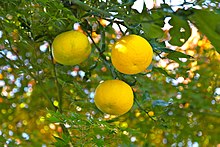Citrus junos
| Yuzu | |
|---|---|
 |
|
| Scientific classification | |
| Kingdom: | Plantae |
| (unranked): | Angiosperms |
| (unranked): | Eudicots |
| (unranked): | Rosids |
| Order: | Sapindales |
| Family: | Rutaceae |
| Genus: | Citrus |
| Species: | C. junos |
| Binomial name | |
|
Citrus junos Siebold ex Tanaka |
|
Citrus junos or yuzu (from Japanese ユズ) is a citrus fruit and plant in the family Rutaceae. It is called yuja (from Korean 유자) in Korean cuisine context. Both Japanese yuzu and Korean yuja are cognates of Chinese yòuzi (柚子), but the Chinese word means pomelo. Yuzu is called xiāngchéng (香橙) in Chinese.
The fruit looks somewhat like a small grapefruit with an uneven skin, and can be either yellow or green depending on the degree of ripeness. Yuzu fruits, which are very aromatic, typically range between 5.5 and 7.5 cm in diameter, but can be as large as a regular grapefruit (up to 10 cm or larger).
Yuzu forms an upright shrub or small tree, which commonly has many large thorns. Leaves are notable for a large petiole, resembling those of the related kaffir lime and ichang papeda, and are heavily scented.
Yuzu closely resembles sudachi (a Japanese citrus from Tokushima Prefecture) in many regards; they share a similar mandarin-ichang papeda ancestry, though yuzu eventually ripen to an orange colour, and there are subtle differences between the flavours of the fruit.
The Yuzu originated and grows wild in central China and Tibet. It was introduced to Japan and Korea during the Tang Dynasty and it is in these nations that it is cultivated most widely.
It is unusual among citrus plants in being relatively frost-hardy, due to its cold-hardy C. ichangensis ancestry, and can be grown in regions with winters at least as low as -9 °C (15 °F) where more sensitive citrus would not thrive.
In Japan, an ornamental version of yuzu called hana yuzu (花ゆず, 花柚子?) "flower yuzu" is also grown for its flowers rather than its fruit. A sweet variety of yuzu known as the yuku, only present in Japan, became severely endangered during the 1970s and 1980s; a major attempt has been made to revive this varietal in southern Japan. Another variety of yuzu in Japan, with knobby skin is called shishi yuzu (獅子柚子?, literally "lion yuzu").
...
Wikipedia
